[Event Report] ECCT-GWEC 2022 Global Offshore Wind Summit - Taiwan (GOWST) 全球離岸風電產業高峰會

- Photo Gallery: Facebook
- Summit Recording
- GOWST Highlight Video
- Press Coverage
- Speaker Presentation Slides (Please send your request to the LCI at zene.fan@ecct.com.tw)
- Media Interviews:
- ICRT
- Wind Taiwan
- EnergyOMNI
The 2022 Global Offshore Wind Energy Summit - Taiwan (GOWST) was organised for the fourth consecutive year by the ECCT and the Global Wind Energy Council (GWEC), co-organised by the Taiwan International Ports Corporation (TIPC) and the Metals Industries Research & Development Center (MIRDC) and endorsed by Taiwan’s Ministry of Economic Affairs (MOEA) and Ministry of Transportation and Communications (MOTC). The opening day of the summit was attended by an audience of 400 in person and virtually. This year’s flagship two-day event featured keynote speeches and high-level panel discussions between policymakers, offshore wind energy industry leaders from Europe, Taiwan and the Asia Pacific region, port authorities and supply chain stakeholders engaged in offshore wind energy development in Taiwan. The event comes at a crucial time as the first round of auctions for Phase 3 of Taiwan’s offshore wind energy projects (also known as Round 3) have just been held for 3GW of additional offshore wind capacity, set to be installed in 2026 and 2027.
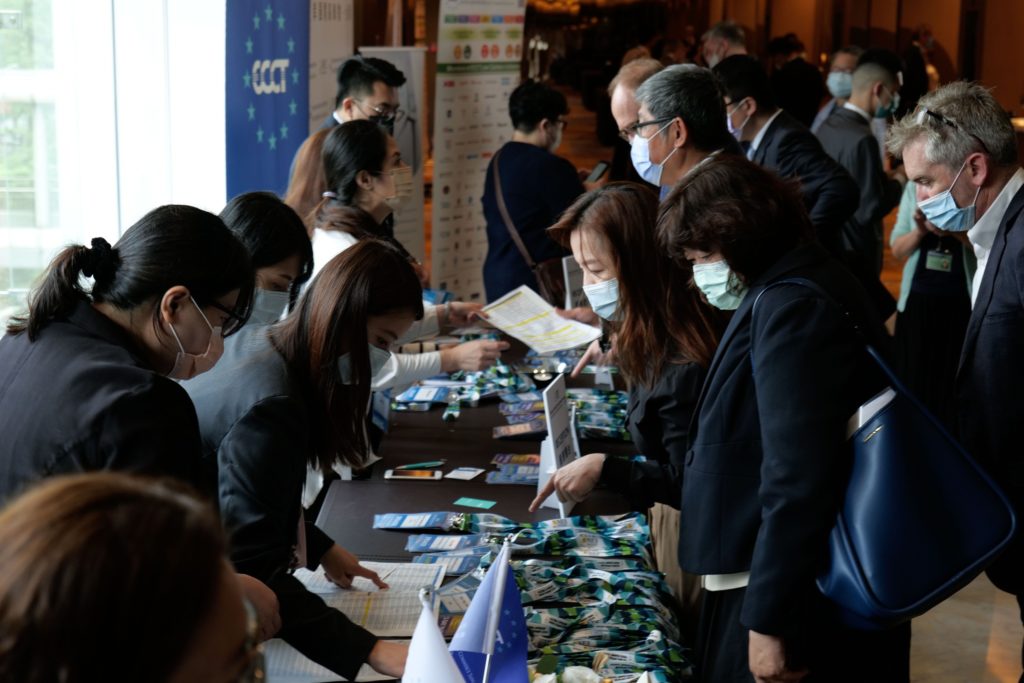
The two-day event featured sessions on a full range of topics covering the outlook for the Asia Pacific region, developments in Taiwan, including Taiwan's offshore wind localisation policy, enhancing port infrastructure, wind turbine technology, construction technologies, energy storage and electricity transmission infrastructure, vessels, logistics, floating offshore wind, the CPPA market in Taiwan and personnel, training, and safety issues. Day 1 was concluded with a dinner that was attended by VIP guests from government and industry.
17 Oct. 2022 Day 1
Opening remarks
The event began with opening remarks by Shen Jong-Chin, Vice Premier, Executive Yuan (沈榮津 中華民國行政院副院長); Wang Mei-Hua, Minister, MOEA (王美花 中華民國經濟部部長); Giuseppe Izzo, Vice Chairman, ECCT (尹容 歐洲在臺商務協會副理事長) and Mark Hutchinson, Head of Asia, GWEC (全球風能理事會亞洲總監).
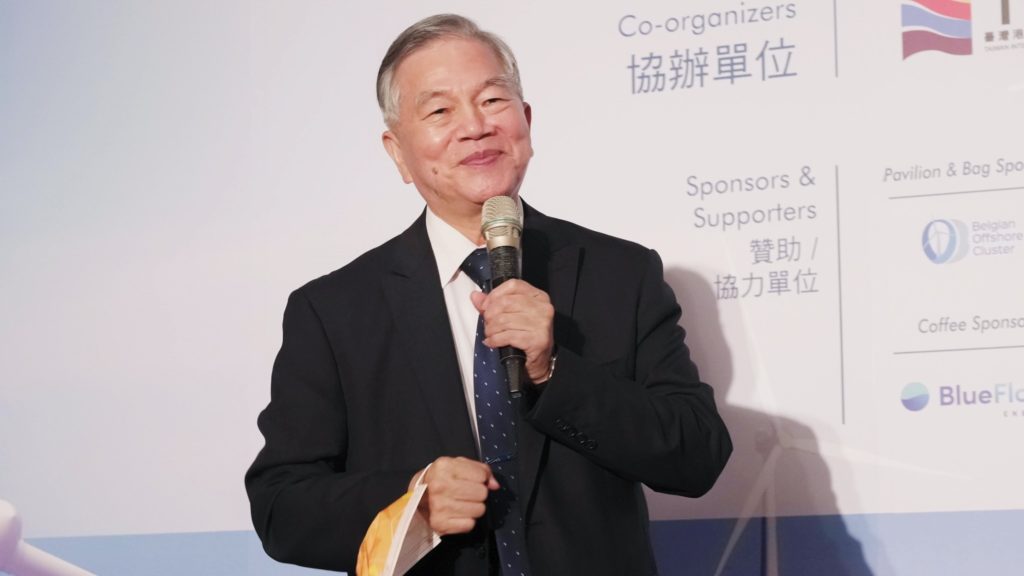 Shen Jong-Chin, Vice Premier, Executive Yuan 沈榮津 行政院副院長
Shen Jong-Chin, Vice Premier, Executive Yuan 沈榮津 行政院副院長
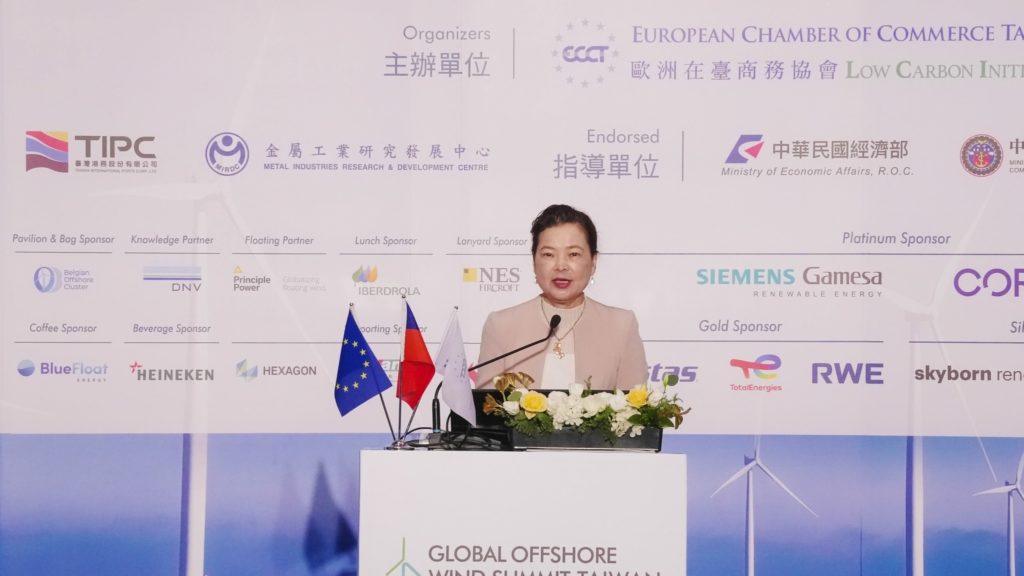 Wang Mei-Hua, Minister, MOEA 王美花 經濟部部長
Wang Mei-Hua, Minister, MOEA 王美花 經濟部部長
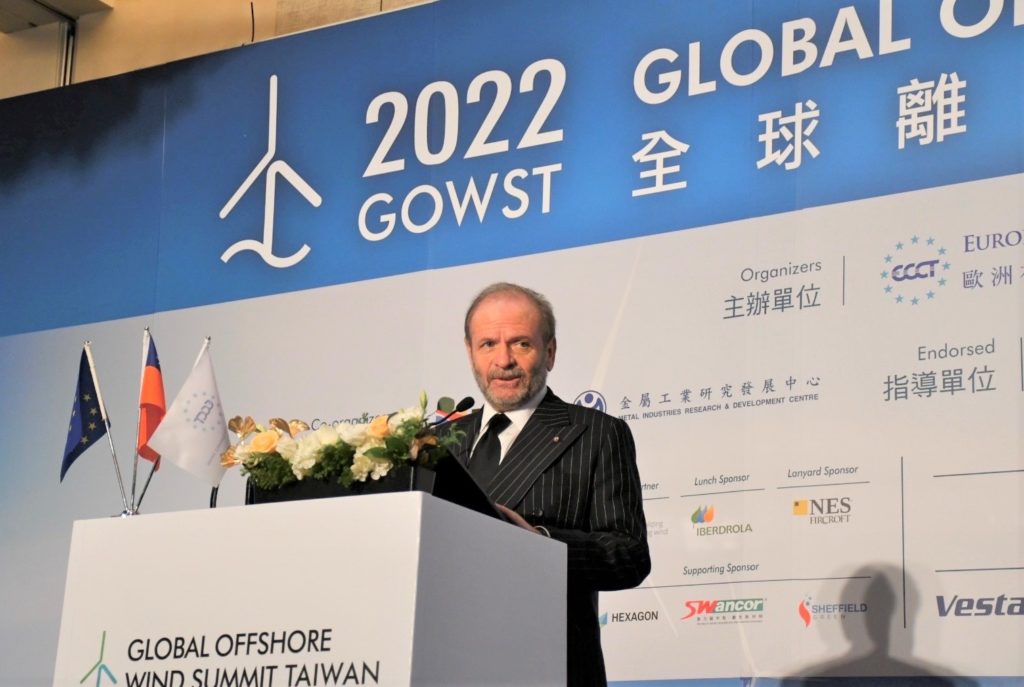 Giuseppe Izzo, Vice Chairman, ECCT 尹容 歐洲商會副理事長
Giuseppe Izzo, Vice Chairman, ECCT 尹容 歐洲商會副理事長
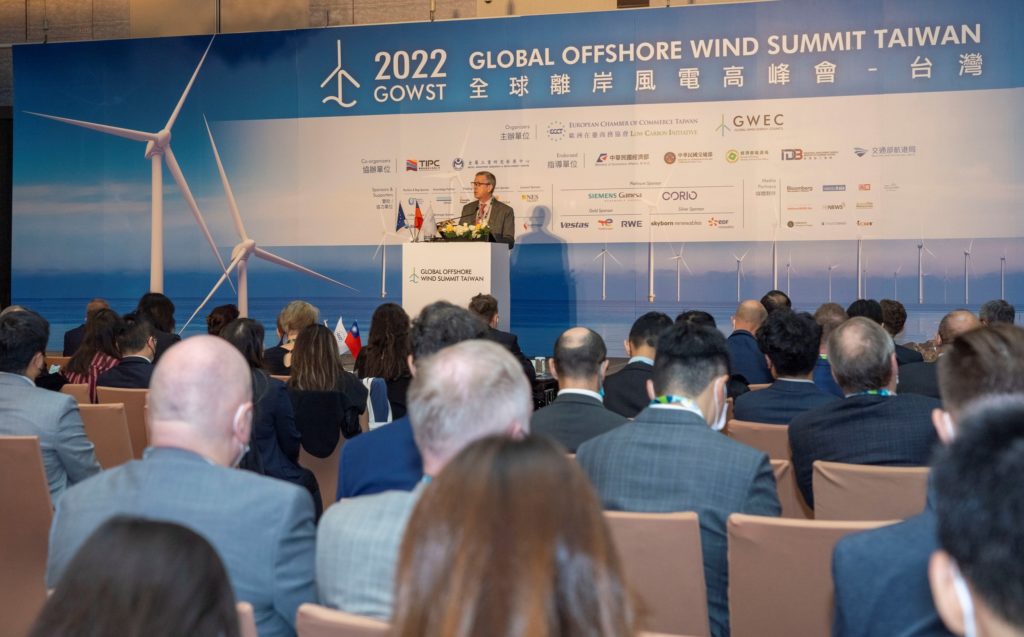 Mark Hutchinson, Head of Asia, GWEC 全球風能理事會亞洲總監
Mark Hutchinson, Head of Asia, GWEC 全球風能理事會亞洲總監
High level offshore wind forum 1
Moderator: Mark Hutchinson, Head of Asia, GWEC
This first forum featured presentations by the following government officials:
- Yu Cheng-wei, Director General, Bureau of Energy (BOE), MOEA (游振偉 中華民國經濟部能源局局長)
- Cheng Shu-hui, Vice President, TIPC (鄭淑惠 臺灣港務公司業務副總經理)
- Yang Chih-ching, Deputy Director-General, Industrial Development Bureau (IDB), MOEA (楊志清 經濟部工業局副局長)
- Liu Chih-hung, Deputy Director-General, Maritime Port Bureau (MPB, MOTC劉志鴻 交通部航港局副局長).
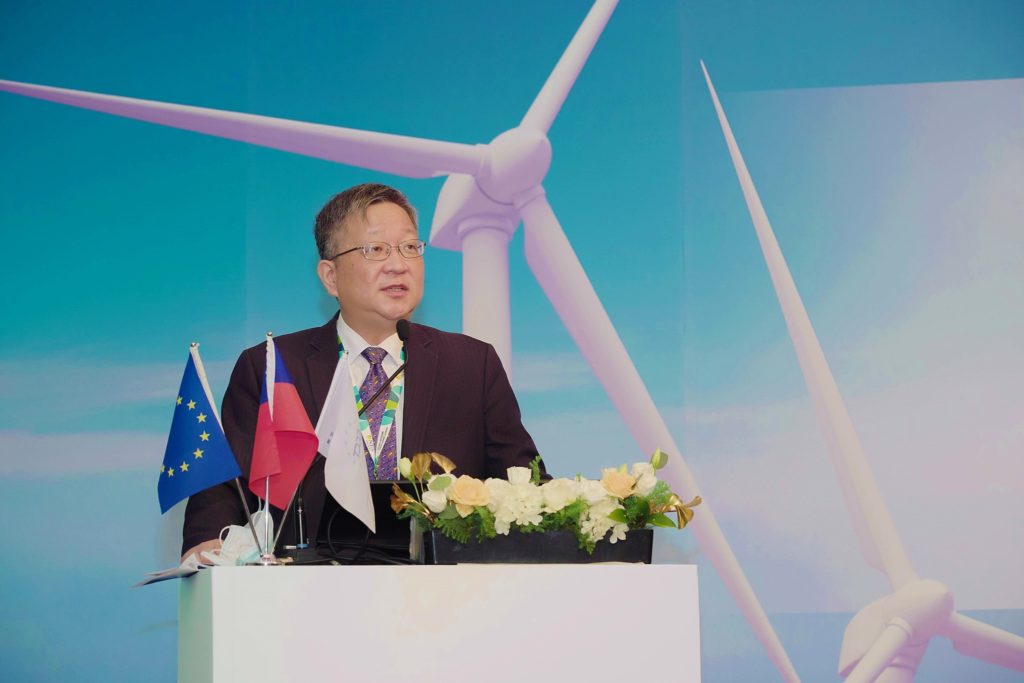 Yu Cheng-wei, Director General, Bureau of Energy (BOE), MOEA 游振偉 經濟部能源局局長
Yu Cheng-wei, Director General, Bureau of Energy (BOE), MOEA 游振偉 經濟部能源局局長
In his presentation, BOE DG Yu Cheng-Wei said that electrification will be most important part of Taiwan’s energy transition. Renewable energy from wind and solar will eventually account for 60-70% of the energy mix, while additional power will come from geothermal sources while hydrogen also play a role in the energy transition. As of end of September 158 offshore turbines have been installed with a capacity of 186.2MW. In phase 3 there will be optional and mandatory items subject to local content requirements and the number has been reduced from 100% originally to 60%. Six developers participated in the first round of phase 3 auctions for 11 projects with capacity of 3GW. In the second round of auctions, some adjustments may be made if necessary. The BOE will finalise and announce details for a floating wind energy demonstration project by early next year.
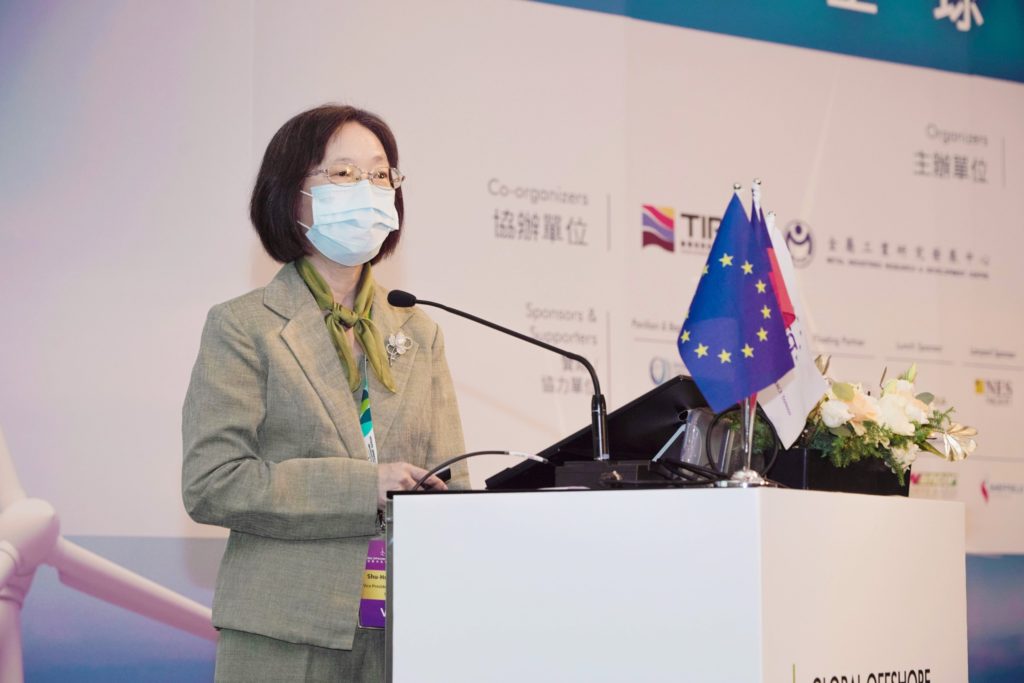 Cheng Shu-hui, Vice President, TIPC 鄭淑惠 臺灣港務公司業務副總經理
Cheng Shu-hui, Vice President, TIPC 鄭淑惠 臺灣港務公司業務副總經理
Cheng Shu-Hui, Vice President of TIPC gave an overview of TIPC’s role in offshore wind energy development. She noted that TIPC had set up a number of subsidiaries to support offshore wind energy, such as one to manage vessels and another for training aspects. A training centre is already providing training courses and is also working with Japanese training institutions. She described the different areas of Taichung Port and where land has been set aside for local manufacturing. Anping port is dedicated to storage for offshore wind energy components. There are also expansion plans for Taipei and Kaohsiung harbours. Infrastructure will be upgraded to support floating wind.
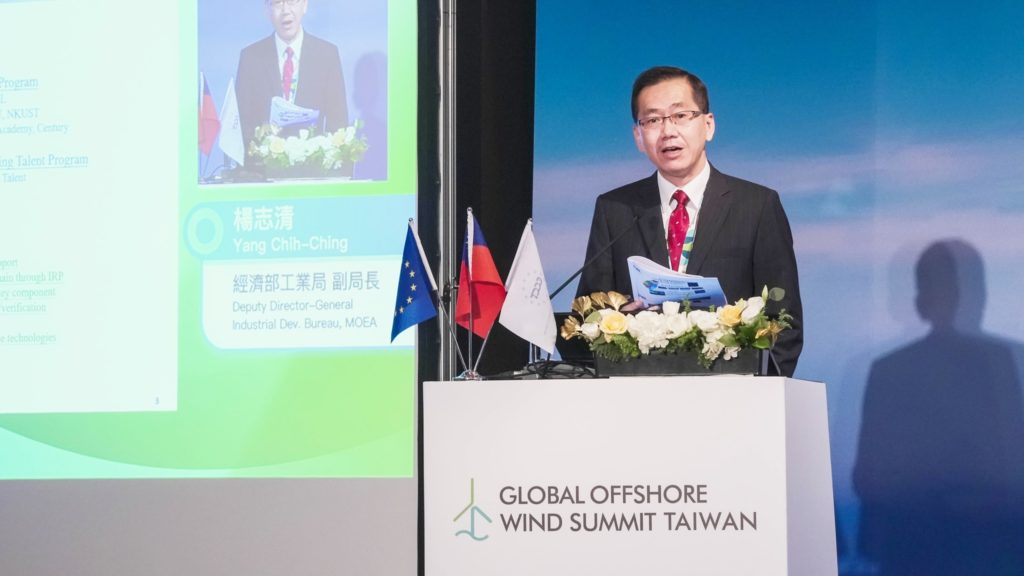 Yang Chih-ching, Deputy Director-General, Industrial Development Bureau (IDB), MOEA 楊志清 經濟部工業局副局長
Yang Chih-ching, Deputy Director-General, Industrial Development Bureau (IDB), MOEA 楊志清 經濟部工業局副局長
IDB Deputy DG Yang Chih-Ching gave an overview and update of industrial policy for offshore wind. He touted a national credit guarantee scheme available to industry players. The government also provides resources for training programmes. He noted progress made by local firms in partnership with European firms. On localisation, he suggested that policies could be adjusted in future based on industry feedback, such as commercial contracts and to deal with rising costs, noting that risk and cost sharing should be fair.
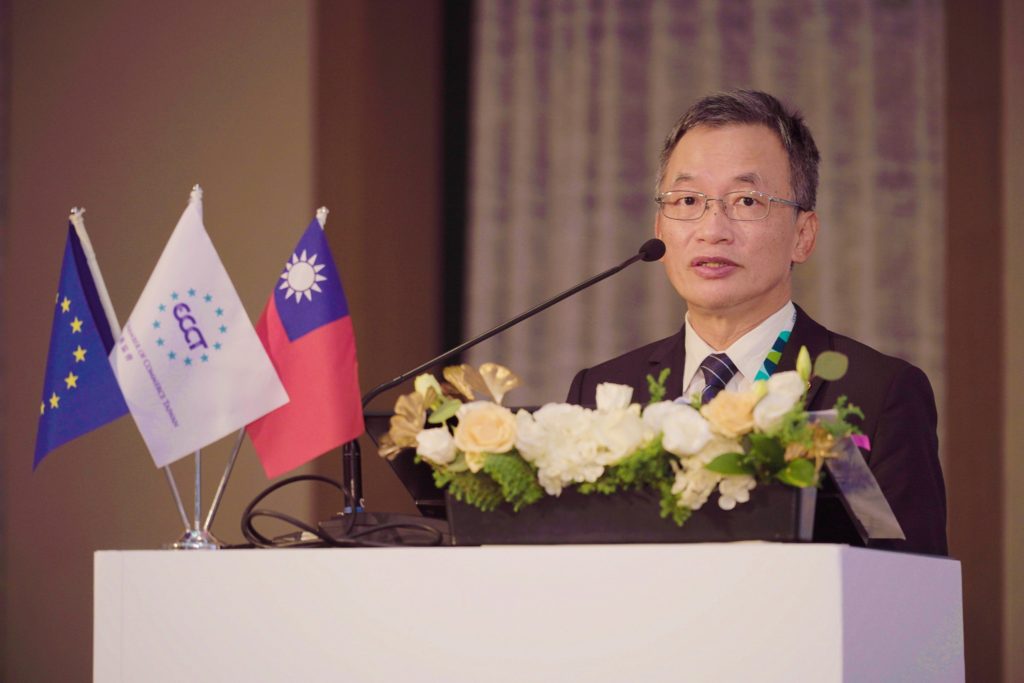 Liu Chih-hung, Deputy Director-General, Maritime Port Bureau MPB, MOTC 劉志鴻 交通部航港局副局長
Liu Chih-hung, Deputy Director-General, Maritime Port Bureau MPB, MOTC 劉志鴻 交通部航港局副局長
MPB Deputy DG Liu Chih-hung gave an overview of his bureau’s role regarding vessels. He said that the MPB is trying to expand the crew employment market and reducing administrative processes. It is working with Belgium to get training programmes recognised by other countries and provide online training programmes. Personnel from Belgium have been asked to certify Taiwan’s training institutions so that locals can qualify to work on Belgian vessels. In terms of administrative processes, there is a single process window and a parallel review process with the BOE to speed up permission for foreign ships to come to Taiwan. He said that he hoped other countries will follow the Belgian model.
High level offshore wind forum 2
Moderator: Mark Hutchinson, Head of Asia, GWEC
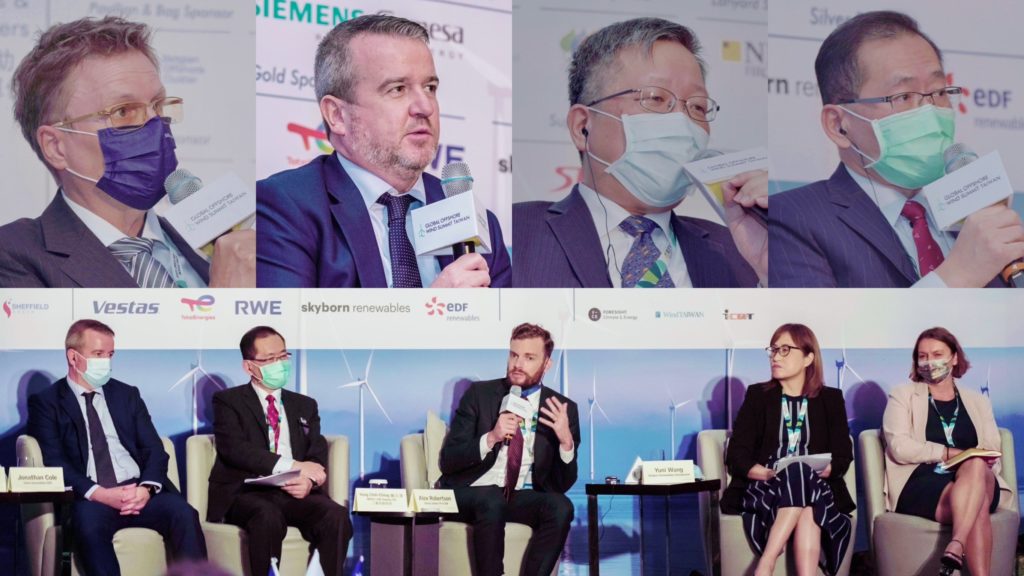
In the second forum session, the following industry experts joined the government participants from the first forum session:
- Jonathan Cole, CEO, Corio Generation
- Niels Steenberg, Chairman and Managing Director of Siemens Gamesa Offshore for Asia-Pacific
- Alex Robertson, Vice-President, General Manager of Vestas Taiwan
- Louise Damgaard Nielsen, Head of Offshore Wind, Taiwan, TotalEnergies
- Yuni Wang, Chairperson, Skyborn Renewables
- Jose Oriol Hoyos, Offshore APAC Director, Iberdrola
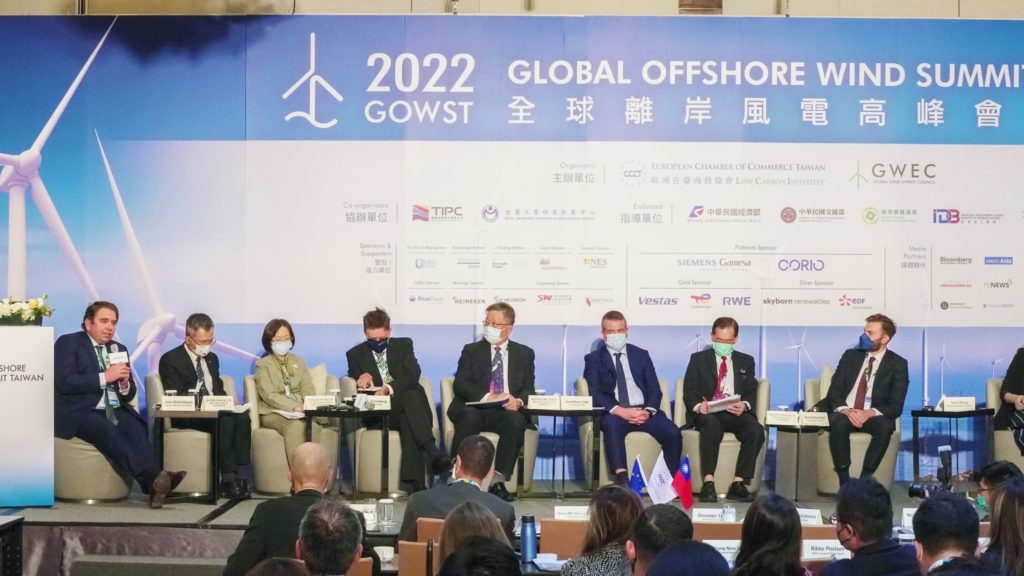
The views of panellists were generally positive about the potential of Taiwan’s offshore wind energy market and panellists praised the government for its openness and willingness to engage with industry. However, they also expressed caution about regulatory bottlenecks and other impediments to development. One panellist acknowledged that while there has been a lot of criticism of the slow pace of development, in some respects things are actually going faster than expected and progress has been made in producing some materials and components locally. Some investors see Taiwan as a remarkable success story. However, there is still a long way to go and there are a number of problems in ramping up the local supply chain. For this reason, regulators need to ensure that there is sufficient flexibility.
The talent shortage is another challenge, which was exacerbated by the pandemic. European investors also underestimated the costs of operating in Taiwan. At the end of the day, success will be measured in how much energy is produced.
Taiwan’s first auction is a reminder of Germany’s auction in 2017. This was a cautionary tale as only 10% of those projects have since been built. The three main problems in Taiwan are limited size of projects, local content requirements and the price ceiling. To be commercially viable, Taiwan needs to gigawatt scale projects. Otherwise they won’t be cost effective. Rigid localisation requirements will be extremely difficult to meet. For this reason, the ECCT is calling for auction price caps to be removed and to relax localisation requirements to use a value percentage approach rather than a fixed item approach, and even more preferable, to make localisation optional for all components.
While local companies do have ability to be part of the supply chain, the quality, price and delivery time leave room for improvement. Construction delays due to Covid-19 personnel disruptions, for example, had a severe financial impact. In addition, the offshore construction window in Taiwan is only really five months per year, which makes it particularly challenging for developers to complete projects on time. The government should take this into account in setting delivery dates.
Inflation is an increasingly important issue. Everything is becoming more expensive, so it makes sense for renewables to become more expensive. While the price of wind farms has dropped considerably from five years ago, when prices were set two years ago, no one anticipated the impact of recent global developments (such as the pandemic and the war in Ukraine). For this reason, it is not reasonable to expect the price of building wind farms in phase 3 to be cheaper than in phase 2. Authorities should also consider every aspect of the value provided by renewables: not just providing energy but also creating energy security, decarbonisation (addressing climate change) and creating jobs. Taiwan authorities also have much faster expectations to complete projects than other countries, which do not sufficiently consider both the global factors as well Taiwan’s own limitations at this stage of development of the local supply chain. Construction schedules therefore need to be feasible.
Regional outlook session
Moderator: Sean McDermott, Vice Chair, ECCT LCI
Panellists:
- Leo Wang, APAC Wind Analyst, for Bloomberg NEF
- Jin Kato, President, Japan Wind Power Association (JWPA
- Woojin Choi, Vice Chairman, Korean Wind Energy Industry Association (KWEIA
- Bui Vinh Thang, Vietnam Country Manager, GWEC
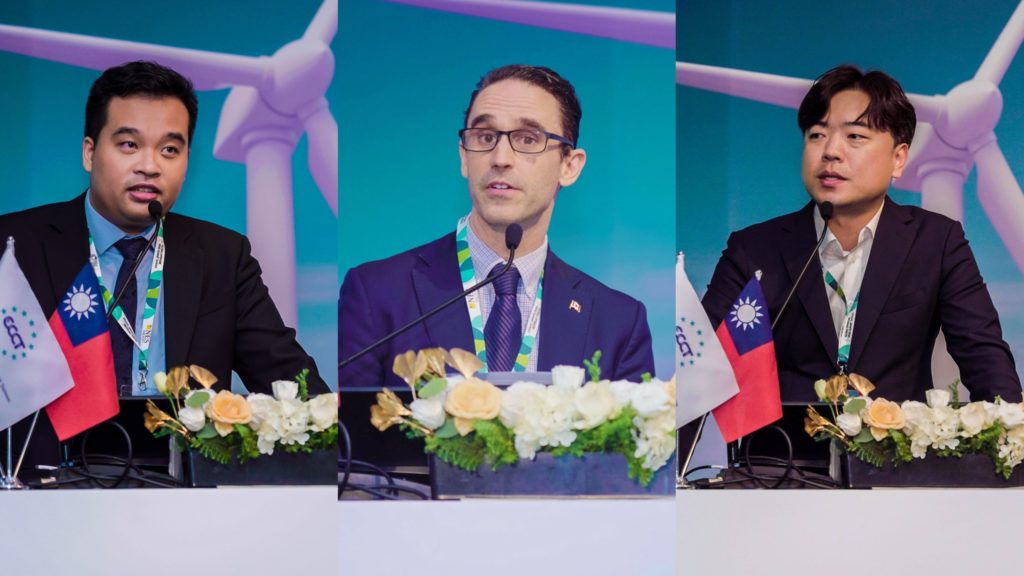 (L-R): Bui Vinh Thang, Vietnam Country Manager, GWEC 全球風能理事會越南區主管經理, Sean McDermott, Vice Chair, ECCT LCI馬聖安 歐洲商會-低碳倡議行動副主席, Woojin Choi, Vice Chairman, Korean Wind Energy Industry Association (KWEIA) 崔宇鎮 韓國風能協會副代表理事
(L-R): Bui Vinh Thang, Vietnam Country Manager, GWEC 全球風能理事會越南區主管經理, Sean McDermott, Vice Chair, ECCT LCI馬聖安 歐洲商會-低碳倡議行動副主席, Woojin Choi, Vice Chairman, Korean Wind Energy Industry Association (KWEIA) 崔宇鎮 韓國風能協會副代表理事
In his presentation, Leo Wang spoke about the APAC offshore wind market, which is set to grow tenfold from 50GW to 500GW by 2035. The market set to become more diverse in future. Emerging market installations will also triple by 2035. China is now world’s largest offshore market, ahead of the UK, which is the next largest. Korea, like Taiwan, faces challenges of local content requirements permitting, grid connection and resources. Only about 6GW of capacity is expected to be added by 2030, well below the government’s target. Floating platforms are likely to be explored earlier than other countries.
India starting auctions this year. 3GW of capacity is expected to come online by 2030, with the first turbines deployed by 2027. Overall, the world is behind schedule in adding wind energy capacity if it is to reach net zero by 2050. Only about 17GW of the needed 300GW per year was installed last year.
In his presentation, Jin Kato spoke about outlook for offshore wind in Japan. The government has set a target for 45GW by 2040. It held its first auction last year for 1.7GW of capacity. 11 ports have been designated as base ports. Challenges ahead include a lack of a predictable pipeline of projects, nationwide grid construction and port infrastructure limitations.
In his presentation, Woojin Choi presented South Korea’s challenges and opportunities. A new act in South Korea has set a target to cut emissions by 40% by 2030 and for renewables to account for 21% of energy. Currently renewables only account for 7.5% of the energy mix. There is great potential for floating offshore wind given South Korea’s strong heavy construction industry and shipbuilding expertise and capacity. Challenges include a lack of grid capacity and interference by local authorities, which have to give final approval for projects.
There is potential for South Korean and Taiwanese cooperation given their shared values, political systems as well as topographies. South Korea’s heavy industries are willing to work with Taiwan in floating offshore wind, according to Choi.
Bui Vinh Thang gave an update on the Vietnam offshore wind market. While it started in 2012, it was off to a poor beginning given low FITs. However, things picked up in 2018 with the introduction of a higher FIT. The current target is for 21GW of onshore and 7GW of offshore capacity by 2030. Vietnam has also committed to reaching net zero by 2050.
Challenges include a lack of legal policy framework. There is also a “north south split” as energy demand in north is higher and expected to increase faster over next 10 years but the best wind energy sites are in the south. International finance is also lacking (local financial institutions are active in solar by limited in wind energy).
High level session 1: Moving Taiwan’s offshore wind to the next level
Moderator: Giuseppe Izzo, Vice Chairman, ECCT
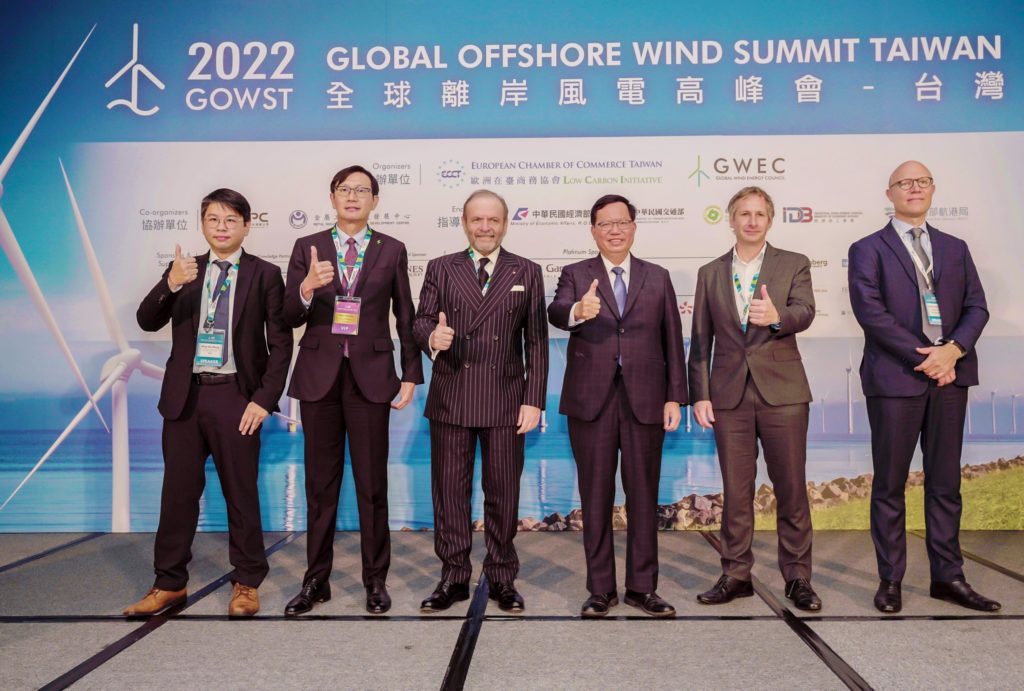 (L-R): Zhang Ming Hui, Head of Renewables Advisory Taiwan of DNV 張明輝 立恩威國際驗證亞太區負責人, Hsu Tsao-hua, Vice President of Taiwan Power Company 徐造華 台灣電力公司副總經理, Giuseppe Izzo, Vice Chairman of ECCT, Cheng Wen-Tsan, Mayor of Taoyuan city 鄭文燦 桃園市市長, Matthew Green, Senior Project Director of Corio 呂麥俢 科理歐永續能源資深專案總監, Patrick Charignon, VP Asia Pacific at EDF Renewables 法國電力再生能源公司亞太市場總裁
(L-R): Zhang Ming Hui, Head of Renewables Advisory Taiwan of DNV 張明輝 立恩威國際驗證亞太區負責人, Hsu Tsao-hua, Vice President of Taiwan Power Company 徐造華 台灣電力公司副總經理, Giuseppe Izzo, Vice Chairman of ECCT, Cheng Wen-Tsan, Mayor of Taoyuan city 鄭文燦 桃園市市長, Matthew Green, Senior Project Director of Corio 呂麥俢 科理歐永續能源資深專案總監, Patrick Charignon, VP Asia Pacific at EDF Renewables 法國電力再生能源公司亞太市場總裁
In his presentation, Cheng Wen-tsan, Mayor of Taoyuan City (鄭文燦 桃園市市長) spoke about current wind energy developments in Taoyuan. Taoyuan can play a role in developing talent while there are many suppliers in Taoyuan willing to work with European developers.
Matthew Green, Senior Project Director at Corio spoke about offshore wind evolution in Taiwan over the past five years through its involvement the Formosa 1, 2 and 3 projects.
Formosa 1 is now fully operational while Formosa 2 is in late stage of construction (Formosa 3 is one of the new projects in Phase 3). While most technical issues were anticipated, what wasn’t anticipated is that seasonal weather only allows a 5–6-month construction period per year. Developers were aware of soil conditions but didn’t consider the effects of earthquakes on the types of soil. In terms of logistics, they didn’t anticipate operating at the end of a stretched supply chain, which extended timelines and increased costs, which were exacerbated by Covid.
In his presentation, Hsu Tsao-hua, Vice President at Taiwan Power Company (台灣電網發展規劃及挑戰 徐造華 台灣電力公司副總經) spoke about Taiwan’s grid development plan and challenges of grid integration. He assured the audience that however much wind power capacity is added, Taipower will be able to integrate it into the grid. Taipower is already investing in new grid infrastructure and planning to build 1.5GW of energy storage by 2025.
Zhang Ming Hui, APAC Offshore Wind Segment Lead, Head of Renewables Advisory Taiwan at DNV (立恩威國際驗證亞太區負責人) spoke about technical challenges associated with floating wind in Taiwan. Floating technology is necessary because there is a lack of fixed bottom sites. While there is enormous potential for growth, costs are still high due to a lack of technology development and synergies.
Patrick Charignon, VP Asia Pacific at EDF Renewables gave EDF’s perspectives on offshore wind. He noted that project timelines are much longer in France – four years for preparation compared to two years in Taiwan. It is also advisable to increase the size of projects in order to reach economies of scale to reduce costs while also producing more energy.
High level session 2: Building port and infrastructure for offshore wind
Moderator: Liu Chih-Hung, Deputy Director General, Maritime Port Bureau (MPB, 劉志鴻 經濟部航港局副局長)
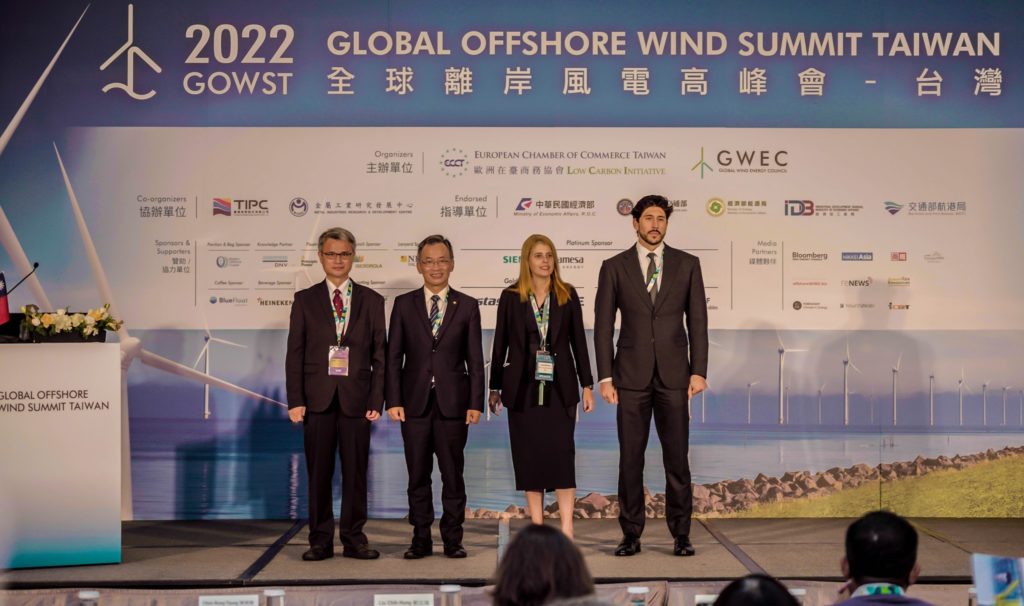
Chen Rung-Tsung, President of Taichung Port, TIPC (台中港離岸風電基礎設施 陳榮聰 臺灣港務公司台中分公司總經理) gave an introduction to infrastructure in Taichung Port.
Jesper Bank, Chief Commercial Officer for the Port of Esbjerg spoke about ports and Infrastructure in Europe.
Jorge Porres, Director, Technology and Supply Chain, BlueFloat Energy gave a presentation titled “A vision for ports tailored for floating wind”.
Tania Moreira, Head of Engineering APAC, RWE gave an overview of RWE’s view of building infrastructure for offshore wind.
Technical Session 2A: Wind turbine technologies
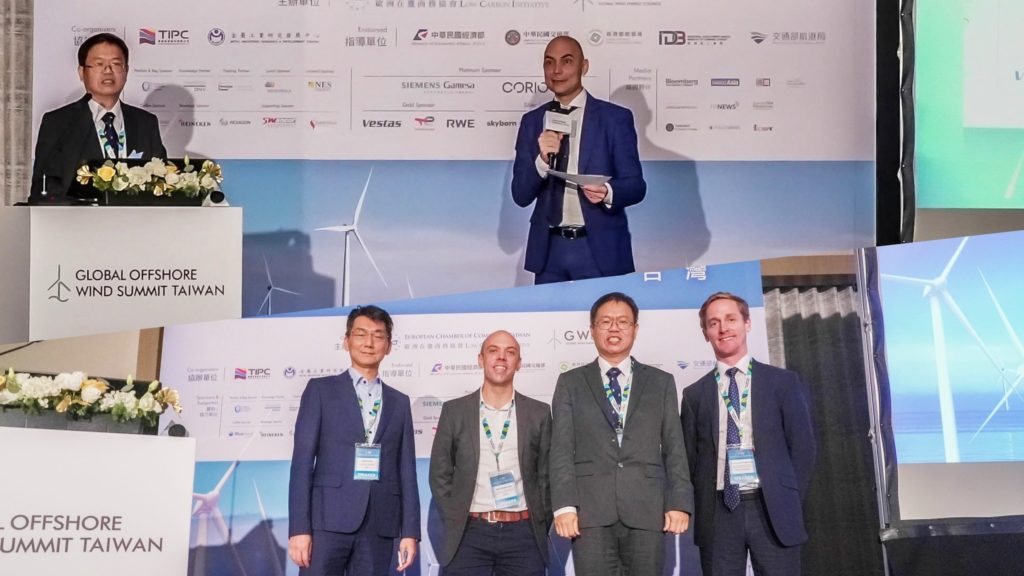
Gero Norman Tschierschke, Head of New Markets of Siemens Gamesa Offshore for Asia-Pacific gave a presentation on his company’s latest technologies.
Julian Kuo, Executive Assistant to Chairman of Swancor Holding, gave a presentation on wind blade recyclable thermosetting epoxy resin EzCiclo and CleaVER.
Ben Rowlinson, Lead Manager, Technical Bid Management of Japan, Greater Asia and Offshore, Vestas Taiwan spoke on the topic “Modularization: Driving increased customer value through an efficient and sustainable supply chain”.
Dr Albert Ku, Principal Engineer, DNV spoke about DNV’s ACE JIP Project and the seismic design of offshore wind turbines.
Technical Session 2B: Energy storage, substations and cable solutions
Moderator: Lee Chun-li, Deputy Director-General, BOE, MOEA (經濟部能源局副局長 李君禮)
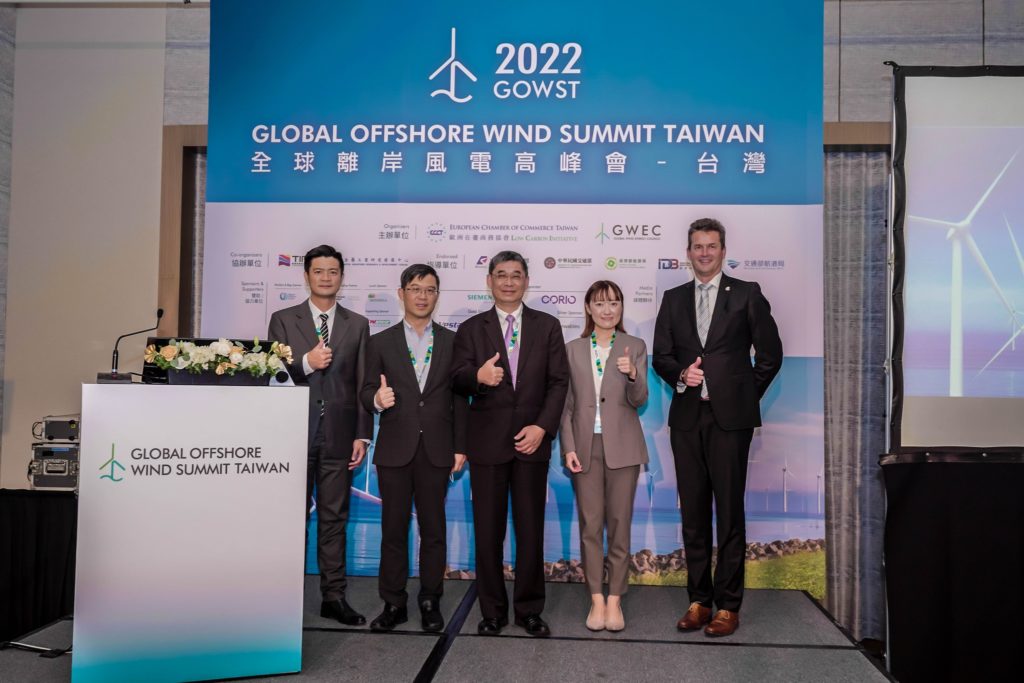
Charles Fernandez, Principal Consultant, Offshore Infrastructure, DNV spoke about offshore substation challenges during fabrication and lessons learned and the importance of certification.
Tsai Yao-huang, Section Chief of the Department of Transmission Line and Substation Projects, Taiwan Power Company (蔡曜鍠 台電公司輸變電工程處組長) spoke about substation energy storage system and offshore wind power grid enhancement. Introduced smart grid general planning framework. He noted that energy storage systems have already been built on Taiwan’s mainland as well as smaller islands of Kinmen and Penghu.
Hu Cheng-hu, Head of Offshore Wind for Bureau Veritas Taiwan Branch (胡承祜 風電負責人 法商法立德公證有限公司) spoke about battery energy storage systems for offshore wind.
Vincent Dehullu, Business Development Manager at e-BO Enterprises spoke about digitalization of wind farm operations & maintenance, offshore substations and cybersecurity. He noted the importance of tracking and managing data as well as people working on wind farms on a common platform as well as workflow. Doing so helps in making the right decisions regarding maintenance and safety and avoids duplication of work. In terms of cybersecurity, it is important to design and implement systems that are able to evolve in order to deal with future threats.
Dr Takami Ueno, Regional Segment Lead – APAC, Renewables Grid Integration for Hitachi gave an overview of her company’s offshore substations and other support systems for offshore wind energy.
VIP Dinner
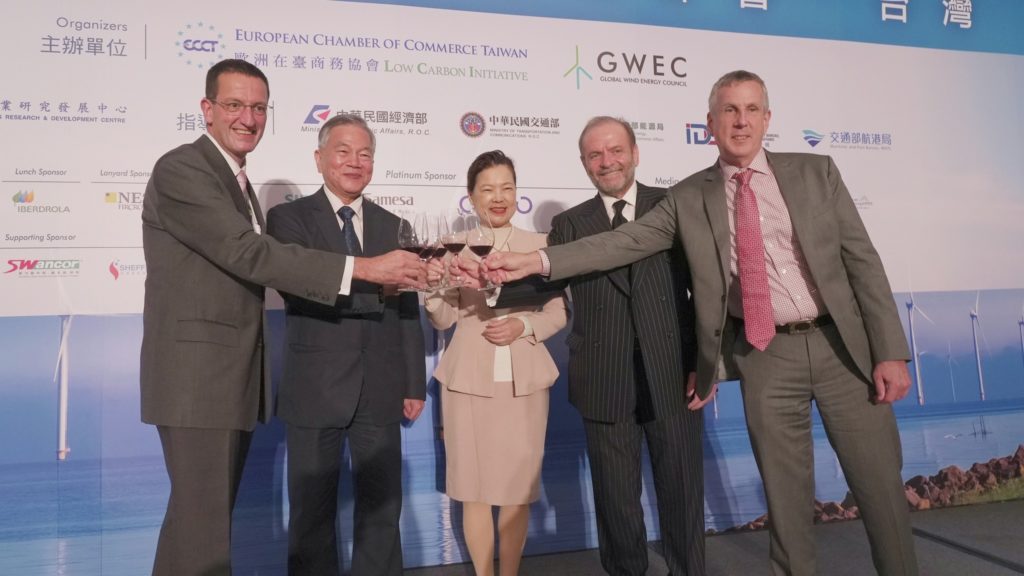
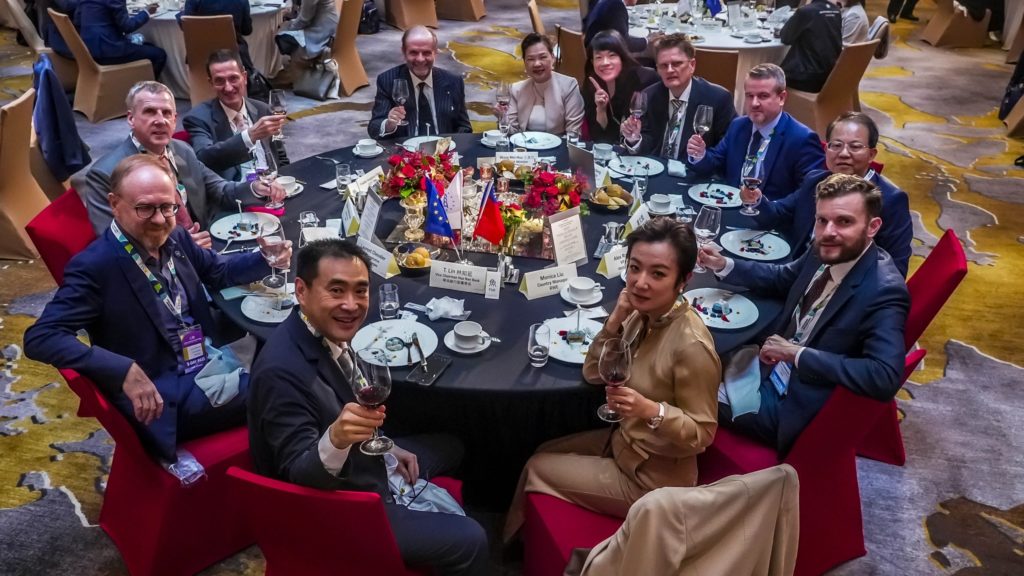
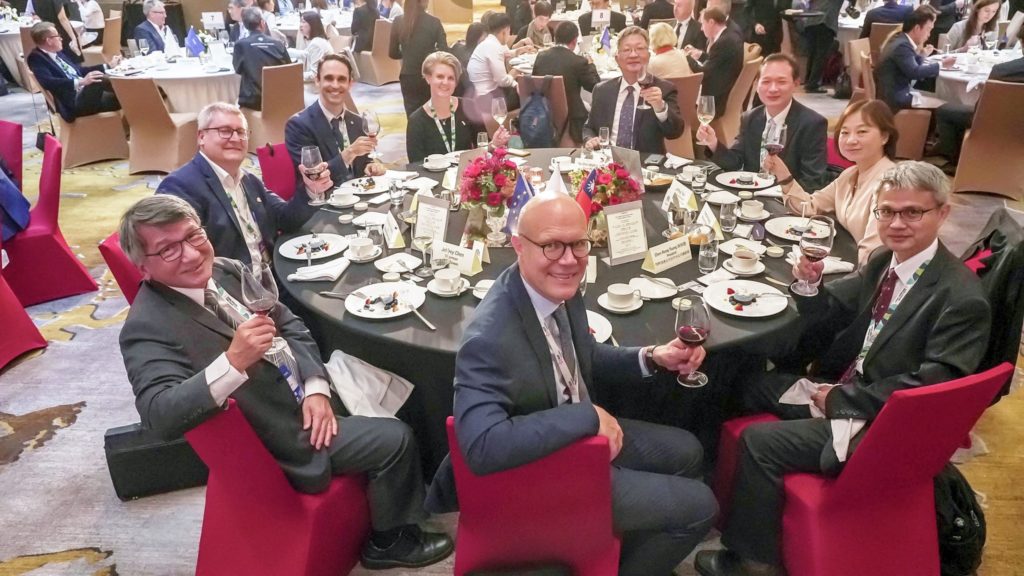
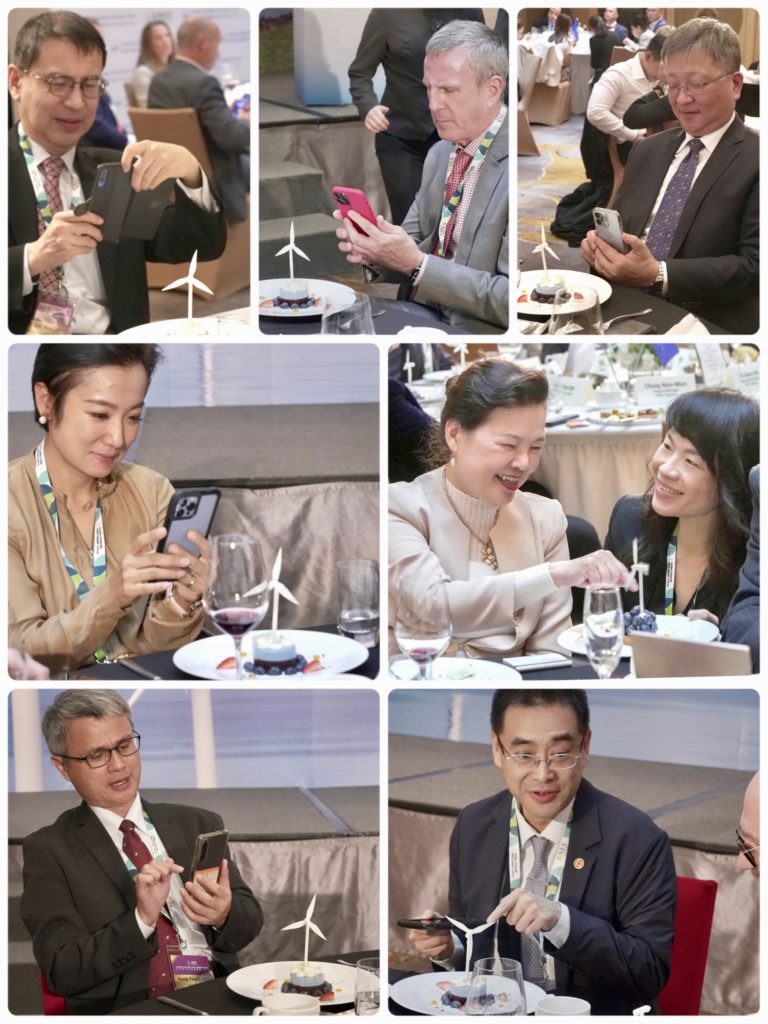
18 Oct. 2022 Day 2
Floating offshore wind forum
Moderator: Mark Hutchinson, Head of Asia, GWEC and MOEA
Panellists:
- Lee Chun-li, Deputy Director-General, BOE, MOEA (經濟部能源局副局長 李君禮)
- Aaron Smith, Chief Commercial Officer of Principle Power
- Pierre-Antoine Tetard, Vice President, Business Development, BlueFloat
- Dennis Mordhorst, Regional Director, Offshore Support Asia Pacific, Vestas Taiwan
- Stuart Quinton-Tulloch, Senior Project Manager Floating Wind, RWE
- Elisabeth Palix, Offshore Technical Lead – APAC, EDF Renewables
- Ole Bigum Nielsen, Head of Engineering & Construction, Corio Generation
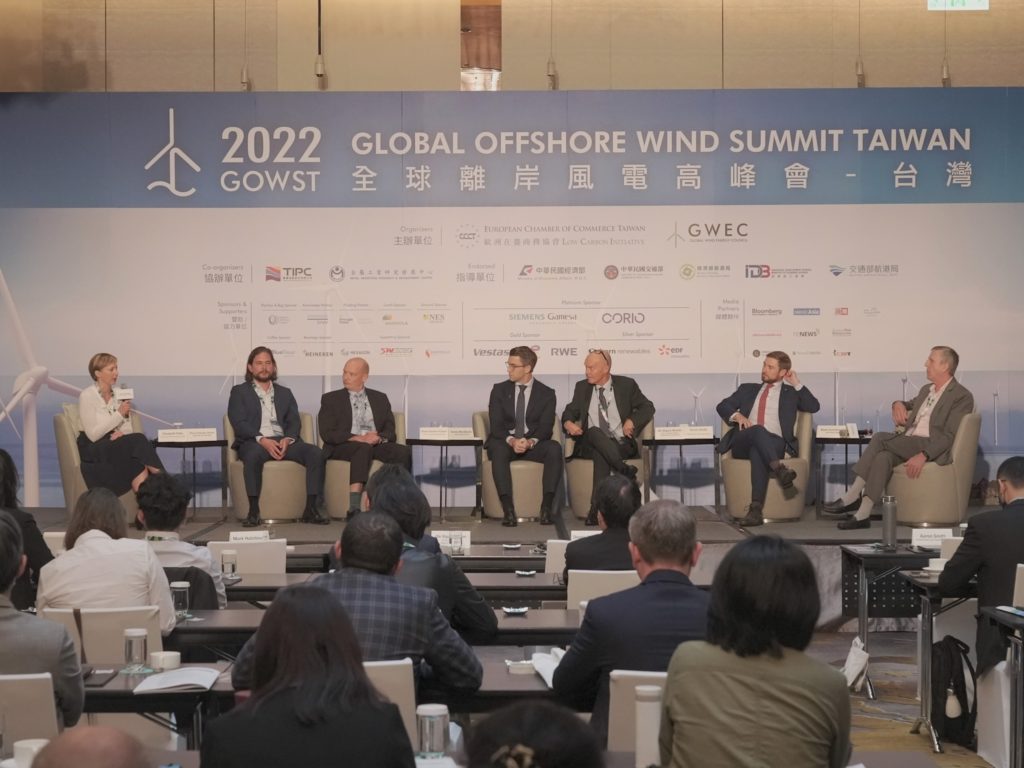
In his presentation, Deputy Director General Lee Chun-li of the BOE (MOEA) gave an overview of Taiwan’s plans for floating offshore wind. The number of floating projects globally is still low, and most are still in the pre-commercial phase, which means that there are a number of competing technologies, such as different types of foundations and anchors.
Floating technology makes sense for Taiwan because it allows for a larger capacity in deep water. In Taiwan’s zonal development phase (phase 3), there is no requirement to use fixed or floating foundations but floating cannot compete with fixed foundations at the moment, which is why the BOE is working on a pilot project. Since platforms can be very large, they will have to be made or at least assembled in Taiwan. This will therefore require additional construction and facilities in Taiwan. Other factors to consider are grid connection (substations and cables) that may be far from mainland Taiwan.
The BOE understands that if the scale (100MW) is small it will be more expensive. Therefore, the BOE is considering raising the FIT rate for the pilot project. One reason for Taiwan’s current limited ambitions for floating wind power is the realisation that Taiwan’s port infrastructure is already limited (and will need to be expanded for the pipeline of projects) while Taiwan has not been focused on heavy industry in recent years (unlike Korea).
Panel discussion
Panellists all noted the great potential for floating wind energy in the Taiwan Strait and agreed that typhoons and other risks can be managed by designs. Several panellists showcased their own designs, which have performed well in pilot or demonstration projects, even in adverse weather conditions. Korea is planning to build large-scale projects while Taiwan authorities prefer to go through a demonstration project. Some panellists said that Taiwan does not need a pilot or demonstration project since there is already enough evidence of proven technologies, which Taiwan could draw from. Other panellists noted that it is difficult to compare different technologies in the early stages and to do this will need more data and analysis. Moreover, conditions in Taiwan may vary from those in other countries. For Taiwan to succeed, it needs to set clear objectives.
All panellists made the point that developing a local supply chain is crucial for floating projects. Projects should be large enough for the particular phase. If they are too small you will lose the talent and expertise (people may leave after initial projects if there is not a sufficient pipeline) while, without industrialised mass production and economies of scale, projects would be too expensive. Taiwan may have trouble finding enough suppliers to be able to deliver to meet the development needs.
Finding talent will also be a challenge since Taiwan does not have experience from the oil and gas sector, that many offshore wind developers in Europe have drawn upon. Floating platforms also need a lot of space to build onshore.
CPPA market in Taiwan after Phase 3
Moderator: Tsai Yi-tai, Partner of PwC and Leader of ECCT LCI Green Finance, ESG, CPPA Working Group (主持人: 蔡亦臺 資誠會計事務所會計師暨歐洲商會-低碳倡議行動綠色金融、永續經營與企業採購綠電工作小組召集人)
Panellists:
- Huang Chih-wen, Chief of 6th Division Section, Bureau of Standards, Metrology and Inspection (BSMI), MOEA (黃志文 經濟部標檢局第六組組長)
- Raime Chu, General Manager, Business Weekly Group (朱紀中 商業周刊總經理)
- Sean McDermott, Managing Director, Northland Power
- Tim Lee, VP and Chief Strategy Officer of Taiwan Mobile (李廷峰 台灣大哥大副總經理暨策略長).
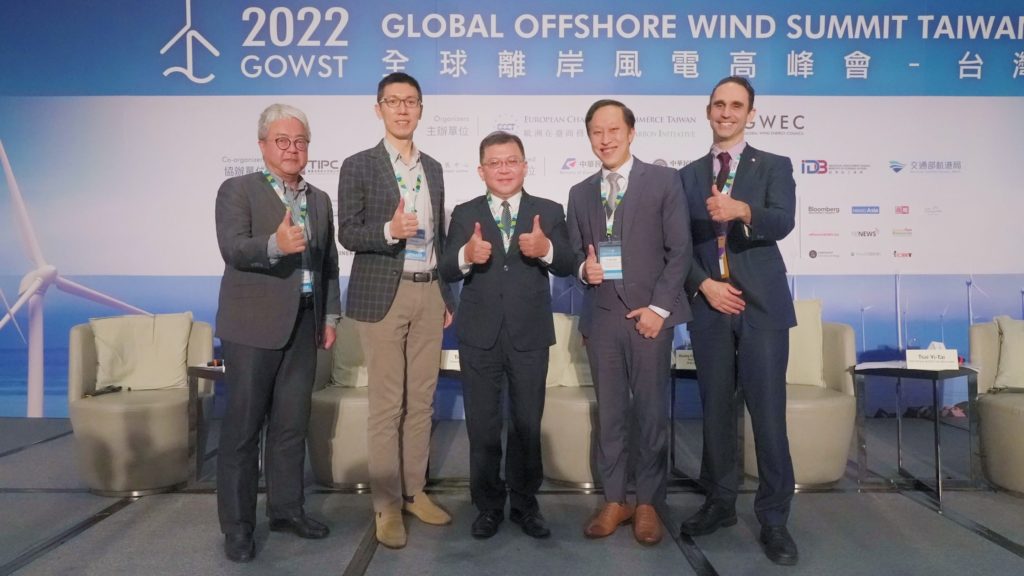
Tsai Yi-tai gave a presentation on international and local practice in green energy trading.
He noted that the number of CPPAs has been soaring as companies seek green energy. Japan is ahead of Taiwan in introducing green energy. Other countries have variable markets but through long term CPPAs, costs can be reduced.
Panel discussion
Huang Chih-wen, on a question about facilitating green power trading, said there are three programmes in place. The green leasing programme model allows companies to purchase green power from the building its office is located in. There is now a group buying option whereby the landlord buys green power on behalf of tenants. Tenants may coordinate amongst themselves, and some may pay more to acquire more energy than others.
The renewable energy market was launched this year to help companies to procure green energy. There is also a certification matchmaking service operating procedures for solar PV. Some public land is leased as solar PV sites. This energy can be purchased, although only a maximum of 30% of an individual company’s energy use can be purchased under this programme in order to give more companies the chance to participate. Huang also welcomed companies to share business models as a reference for the BSMI.
Panellists noted that a lot of future projects will depend on CPPAs in order to provide better returns than selling power to Taipower. The primary reason for CPPAs is that Taiwan lacks a market. TRECs can currently only be sold once and then retired. Wind developers and energy producers don’t have the appetite/resources to sell small amounts of electricity to SMEs. A problem for companies like Taiwan Mobile is that their energy usage is spread over multiple sites (Taiwan Mobile has over 7,000 base stations and hundreds of retail outlets which makes it difficult to secure green energy for each of them individually).
The other big challenge is a lack of supply. Onshore projects are mostly connected to local distribution platforms, which can do what they want with the power. This allows them to raise prices as much as they want. Supply is concentrated in the hands of a few IPPs. Some companies are generating green energy but don’t know how to sell the surplus green energy. There is also the problem of producing a surplus at some times (solar energy at midday, for example or wind energy in winter) or not using energy when it is produced (such as office buildings which are empty over weekends), leading to energy going to waste. According to Huang, an upgraded version of the green lease programme offers variable use cases and prices for users in office buildings. Surplus power on weekends could be used by restaurants or factories. This can be done without revising regulations. In the CPPA you can add a clause to allow you to share power with other parties. You could also sell the power at a cheaper rate depending on the season (for example, wind power could be cheaper in winter).
Another problem in Taiwan is that electricity is too cheap while renewable costs are high, far beneath what developers need to cover costs and earn reasonable margins. Letting the price of RECs float is one way to address this problem.
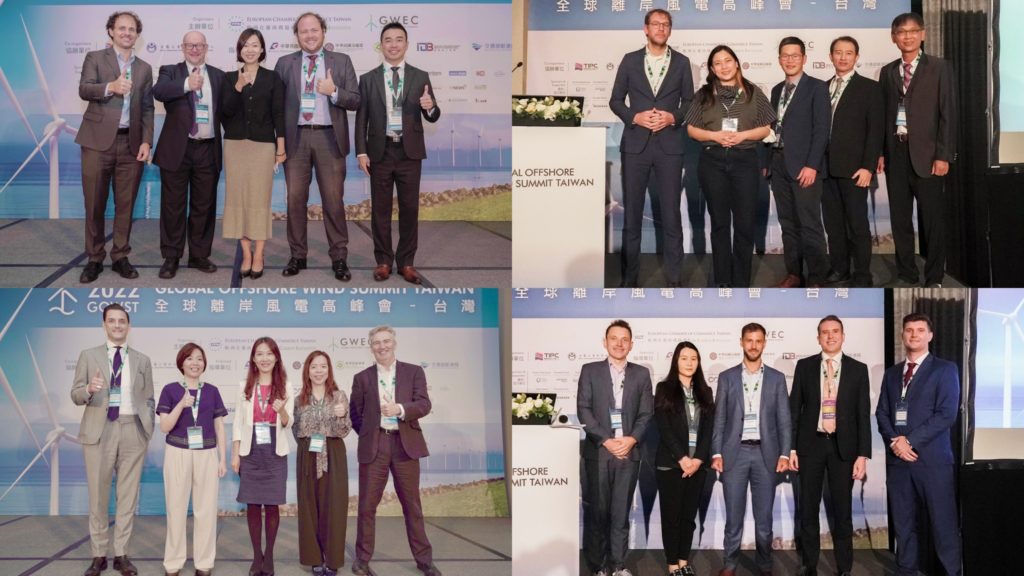
Technical Session 3A: Offshore wind vessels and logistics strategies
In this session, Kelvin Teo, Managing Director of PKR Offshore gave a presentation titled “Embracing localisation & the challenges ahead for offshore wind.
Chris Garrett, Senior Offshore Wind Farm Installation Engineer at DNV spoke about modelling offshore construction with DNV's O2C tool.
Tom Manning, General Manager at CWind Taiwan spoke about solving Taiwan’s Phase 3 logistics conundrum.
Robin Ingram, Wind Power Development Lead at East Asia at Mott Macdonald spoke about vessels and T&I considerations for floating projects.
Technical Session 3B: Training, manpower, safety and other needs in offshore wind markets in Taiwan
Iain Grainger, Head of Energy Transition for International Marine Contractors Association (IMCA) spoke about improving safety performance in the marine contracting industry.
Kelly-Ann Ee, Chair of APAC Focal Group for the G+ Global Offshore Wind Health and Safety Organisation spoke about the prospects for health and safety in Taiwan’s offshore wind market.
Doris Jao, Senior Vice President, Marsh Ltd., Taiwan spoke about how to mitigate risks in offshore wind energy.
Mert Çandarli, Business Development & Sales Manager – Offshore for Tractebel Engineering spoke about system integration and de-risking of projects with engineering expertise.
The final presentation was given by Natasha Wu, Manager – Taiwan for NES Fircroft.
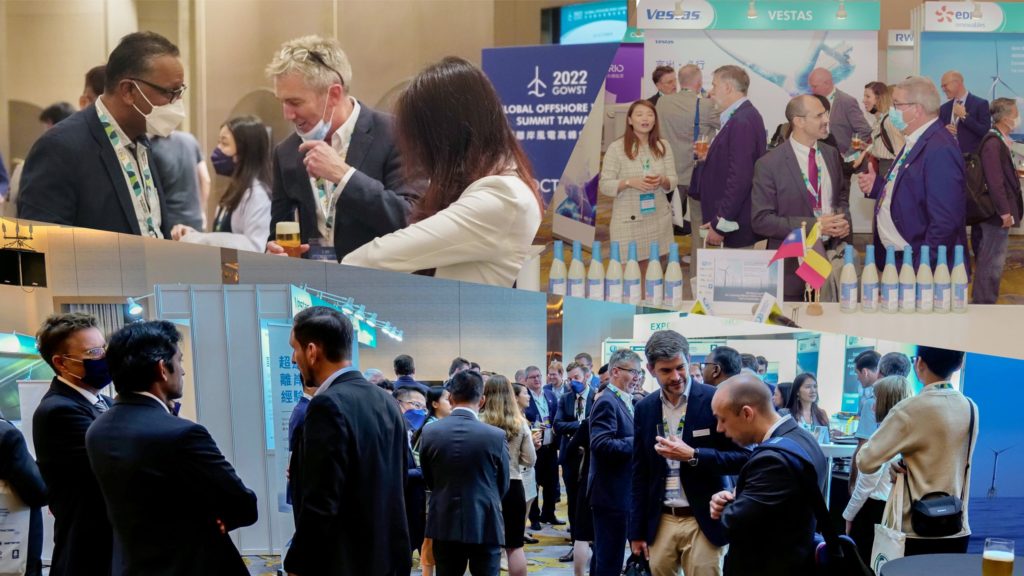
Happy Hour
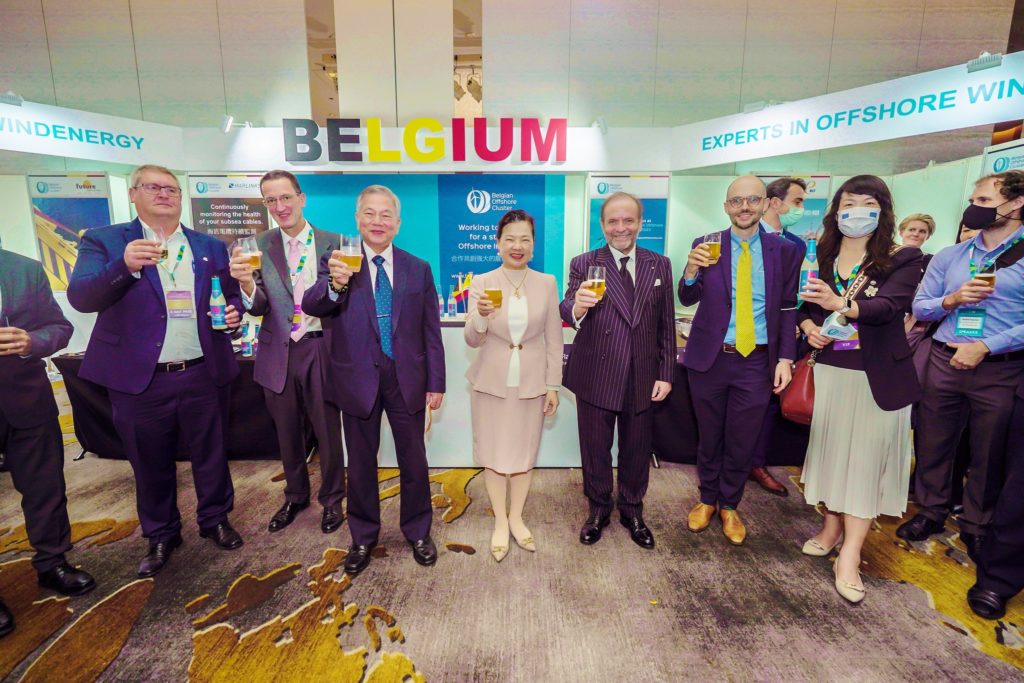
By Belgium Offshore Cluster and Delirium Beer
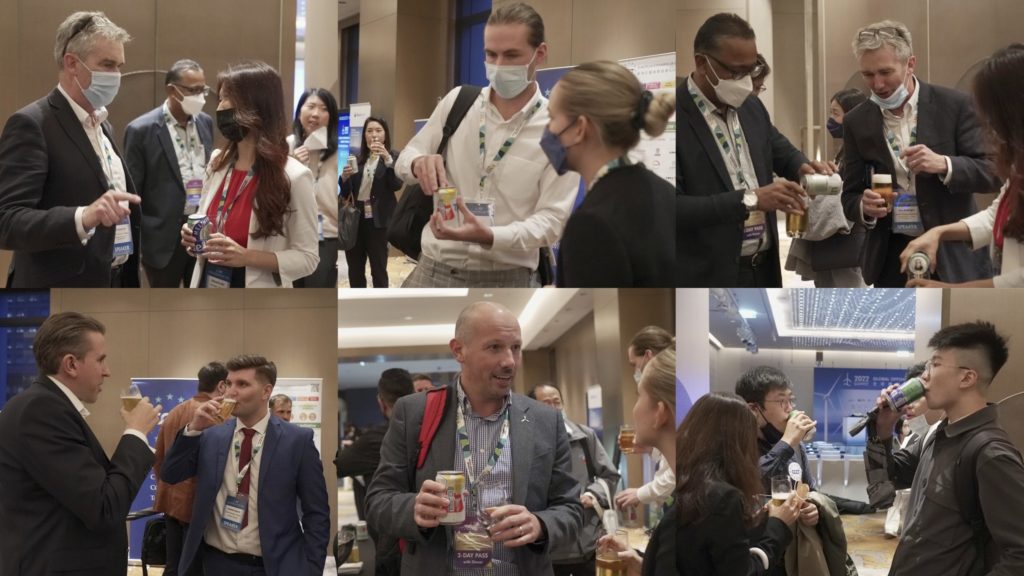
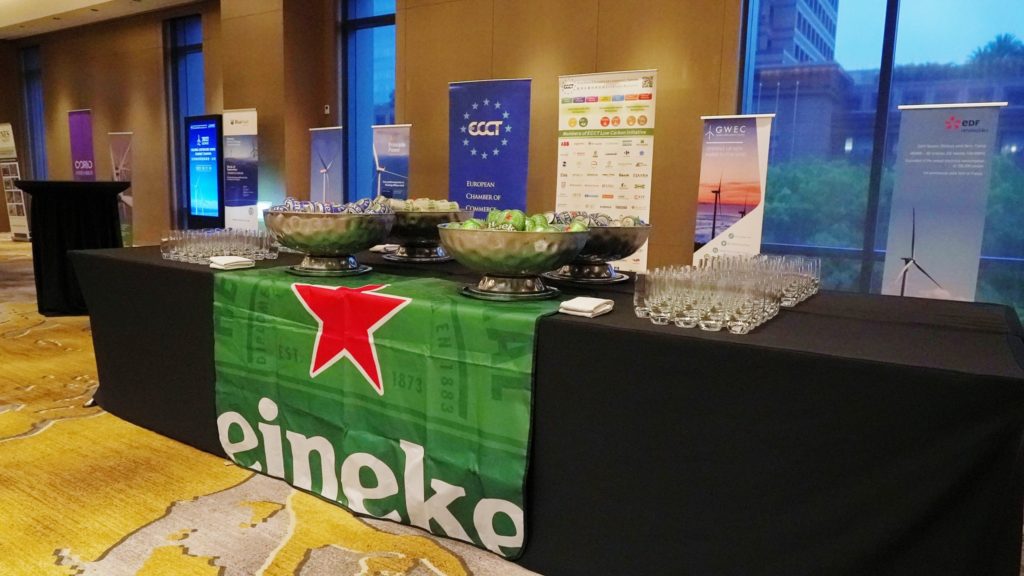
By Heineken
